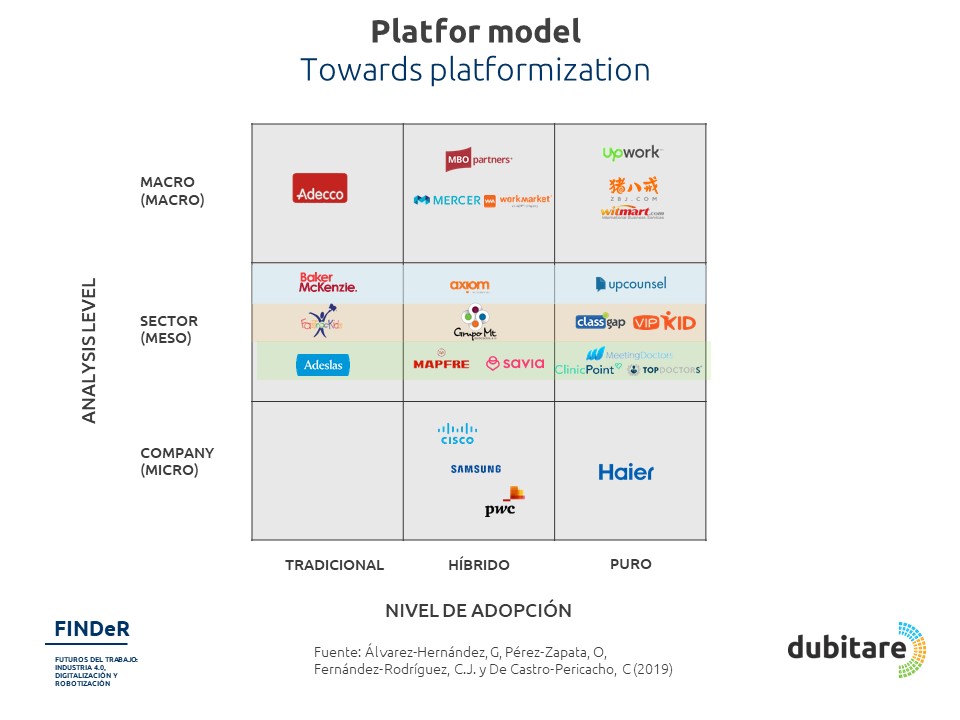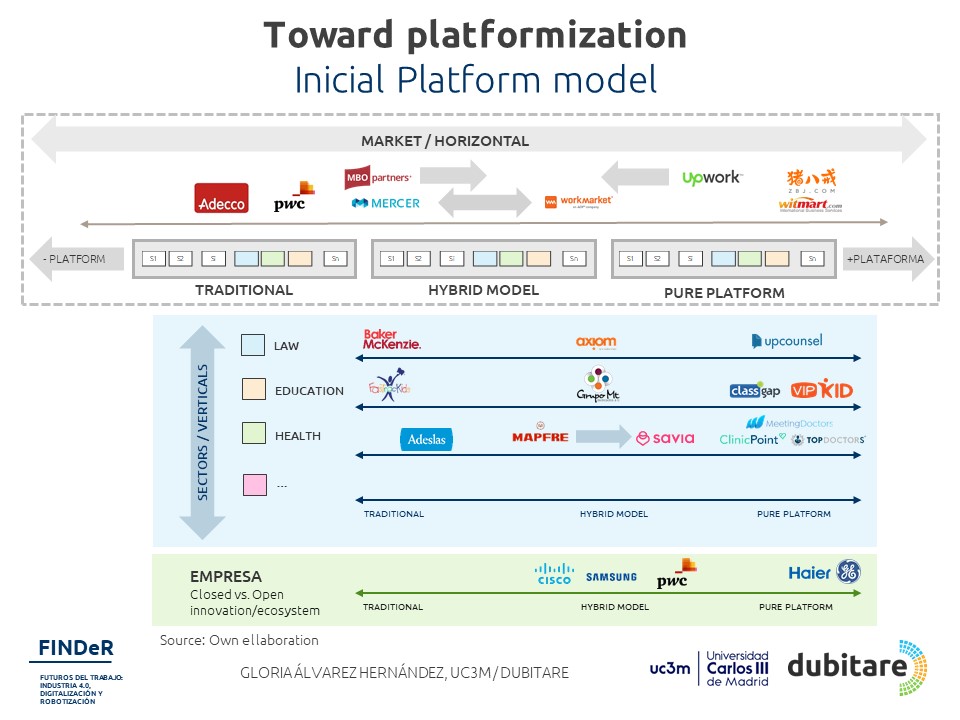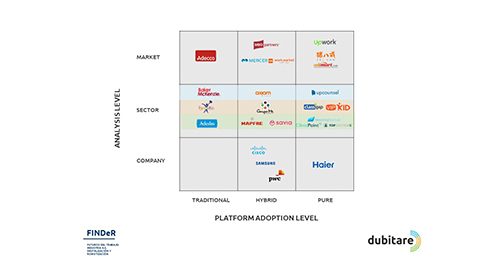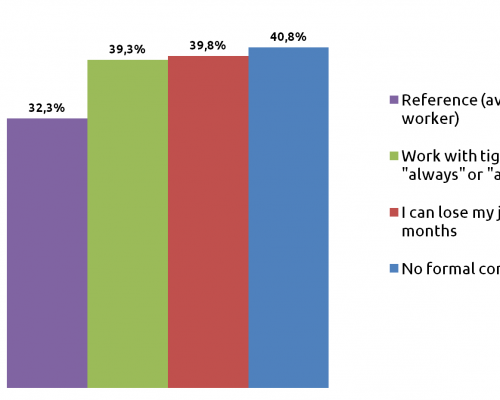Idea dubitare
Blogs
Featured
Management Chino: From the multinational to platform ecosystems
Discussion panel at Science and Innovation Week 2021, Madrid
What can we learn from Chinese companies? How are you coping with today’s business demands? In the discussion panel “Chinese Management: From the multinational to platform ecosystems” we reviewed signs and trends of Chinese management and the platformization of companies and work, where companies and the Chinese government are generating management innovations that combine the best of East and West. In addition, we will integrate perspectives from management, strategy, sociology, politics and technology.
The discussion panel on Chinese Management is organized by Universidad Carlos III de Madrid and Dubitare within the framework of the Science and Innovation Week 2021 of the Community of Madrid. It will have the participation of the analyst and sinologist Águeda Parra Pérez, author of the book “”China, las rutas de poder” (China, the routes of power), the professor Claudio Feijóo González of Universidad Politécnica de Madrid, author of the book “El gran sueño de China. Tecno-socialismo y capitalismo de estado” (The great dream of China. Techno-socialism and state capitalism), Gloria Álvarez Hernández, Professor of the Business Economics Department at Universidad Carlos III de Madrid and Óscar Pérez Zapata, Professor of the Management Department at Universidad Pontificia de Comillas..

Palace Examination at Kaifeng, Song Dynasty, China” Imagen disponible bajo Creative Commons license
- Title: “Management Chino: De la multinacional al ecosistema de plataformas”.
- Date: martes 2 de noviembre de 19:00 a 21:00 horas
- Speakers: Águeda Parra Pérez, Claudio Feijóo González, Gloria Álvarez Hernández y Óscar Pérez Zapata
- Where: Salón de Grados del Campus de Madrid-Puerta de Toledo de la UC3M. c/Ronda de Toledo, 1. ¿Cómo llegar?: https://goo.gl/maps/pBf8AirTs2B2
- Inscription: enviar un e-mail a Dubitare (info@dubitare.com)
- Organizations: UC3M y Dubitare.
- Hashtags: #SemanaCienciaInnovacion, #SemanaCienciaMadrid, #SemanaCienciaUC3M
Companies become platforms. Dubitare-FINDER platform model
The phenomenon of platforms, although incipient, is transversal and is reaching all kinds of sectors, organizations, tasks and qualifications. In this article, we present a new platform model that dubitare and the FINDER group (Futures of Work, Industry 4.0, Digitization and Robotization) have created to estimate the state of platform adoption in a market, sector or company. With this model, you can make regional or country comparisons.
Platform model
Mandl (2009) at Eurofound organized the platform work according to five variables: 1) level of qualification (low, medium, high); 2) the way the service is deployed (in person, online); 3) the scale of the tasks (micro tasks vs. larger projects); 4) the selector / decision maker of the service (depending on whether it is the platform, the client or the worker who starts the activation of the service); and 5) the way in which the client and the worker mediate (offer or contest).
As a result of an investigation that we presented in 2019 at the Interuniversity Congress on the Future of Work in Seville and at the II National Tripartite Conference. The future of work organized by Ministry of Labor, Migration and Social Security and ILO, we have created a new theoretical model of platforms within Dubitare and FINDER research group (Futures of Work, Industry 4.0, Digitization and Robotization) that is compatible with the previous one from Mandl. It is applicable to both, low-skilled and high-skilled platforms. The model places the platforms in a broader context of “platformization”, understood not only as a context where new platforms emerge for the organization of work, but also as a context of progressive use of platforms by already established companies.
We are heading towards the platformization of companies
From the Dubitare-Finder model, represented in the following figure, it emerges that the “platformization”, although still incipient, is much larger than it seems. It is already here and it will reach many corners. The model organizes the platforms combining different levels of analysis
- On the Y axis, depending on the scope (company, sector and market).
- On the X axis, according to the different levels of adoption: 1) traditional companies that do not use platforms, 2) companies that adopt a hybrid model that incorporate platforms or platform services in some link of their value chains, 3) the case of pure platforms, companies that are organized as platforms themselves.
This classification is compatible and complementary to that of Mandl (2019) and seeks a better understanding of the evaluation and scope of “platformization” from the perspective of business organization. It also operates at a higher level, which can frame not only platform work but digital work in a progressive context of “platformization”.

Figure 1. Platformization model. Álvarez-Hernández et al. (2019). dubitare-FINDER
What does the model consist of?
In the matrix of the figure, three levels can be seen.
Macro or task market level
The first case (three upper quadrants) is a modification of one presented in Staffing Industry Analysis (2017). Companies that offer services and tasks of all types of temporary work are shown for all sectors. There are traditional companies on the far left, in the middle, we find companies that start adopting the platform model (MBO partners) or companies that make alliances with platforms (Mercer with Workmarket) and on the far right, the case of pure platform or maximum adoption (Upwork or the Chinese Zhu Bajie and its former international Witmart), which are platforms that connect workers with companies to carry out tasks such as programming, a marketing plan, a translation, some design work, etc.
Meso or vertical level
The same distribution can apply within the same sector or in vertical segments (three middle quadrants). For example, in the education sector, in the language teaching segment, there can exist a neighborhood academy, or a franchise (FasTracKids), a hybrid model with an online platform and face-to-face (Mt Group), or VIPKid with the pure model at the right. It is also applicable to other sectors (law, insurance and health, translation work, etc.).
Micro or company level
The last row of the matrix (three lower quadrants) refers to the way of organizing within the same company. In the first quadrant, you would find a traditional company that does not adopt the platform model. Next, we would have a company that adopts the platform model in a hybrid way, simultaneously maintaining traditional models with platform working models. In this case, the company could decide to build its own platform (eg PwC), or contract platforms for certain activities in the value chain (eg, Samsung and Cisco that use professional platform services). Finally, in the third quadrant we find companies that adopt the model in its pure form. They are organized as a platform for micro-companies or micro-entrepreneurs who have their own profit and loss accounts within the same company, as is the case with the successful Chinese household appliance company Haier.

Figure 2. Initial “platformization” model. Álvarez-Hernández et al. (2018). Interuniversity Congress on the Future of Work in Seville
This new framework will therefore help to estimate the level of platformization or platform adoption in a market, sector or company and to make regional or country comparisons. Depending on the degree of adoption, there will be more or less urgency to generate policies and regulations in this regard.
Sources:
Alvarez-Hernández, G, Pérez-Zapata, O. (2021). Plataformización y “gestión platafórmica””. Revista Española de Sociología, 30 (2). https://dialnet.unirioja.es/servlet/articulo?codigo=7988218
Álvarez-Hernández, G. (2019): “La economía gig, también para los cualificados”, Observatorio De Las Ideas, en https://observatoriodli.com/
Álvarez-Hernández, G.; Pérez-Zapata, O.; Fernández-Rodríguez, C.J. y De Castro Pericacho, C. (2019): “Plataformas y Gig economy en el trabajo cualificado”, Comunicación presentada en el Congreso Interuniversitario OIT sobre el futuro del trabajo, Sevilla, 7-8 de febrero. Pendiente de publicación
Álvarez-Hernández, G.; Pérez-Zapata, O. (2020). Capítulo 6. “Hacia la “plataformización”: el caso de una plataforma digital cualificada”. Libro “Fronteras del trabajo asalariado”. Ed La Catarata.
Corporaal, G. F., & Lehdonvirta, V. (2017): “Platform sourcing: How Fortune 500 firms are adopting online freelancing platforms”. ERC-funded research project iLabour: The Construction of Labour Markets, Institutions and Movements on the Internet. . Oxford Internet Institute. University of Oxford
Mandl, I. (2019): “Trabajo en plataformas ¿Maximización del potencial al tiempo que se salvaguardan los estándares?”, Eurofound, Dublín. Accessible in https://op.europa.eu/es/publication-detail/-/publication/3a432fb5-e595-11e9-9c4e-01aa75ed71a1
Staffing Industry Analysis. (2017). The gig economy and the changing workforce. Asin, B; Francis, D: Pena, Bryan. p38. Accessible in: https://www2.staffingindustry.com/content/download/244240/9055370/170803_BuyerWebinar_FINAL.pdf




